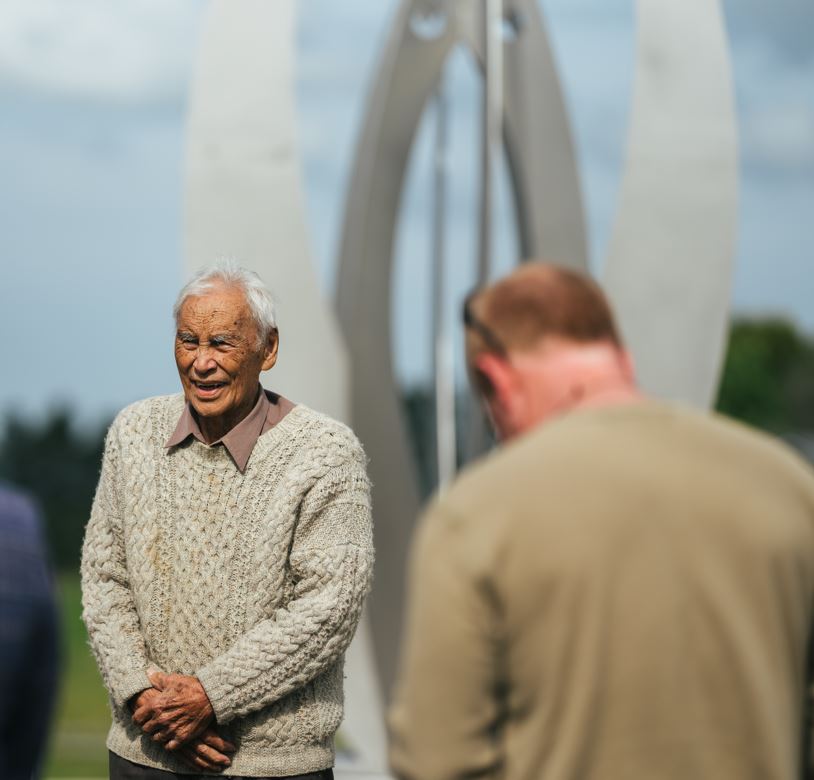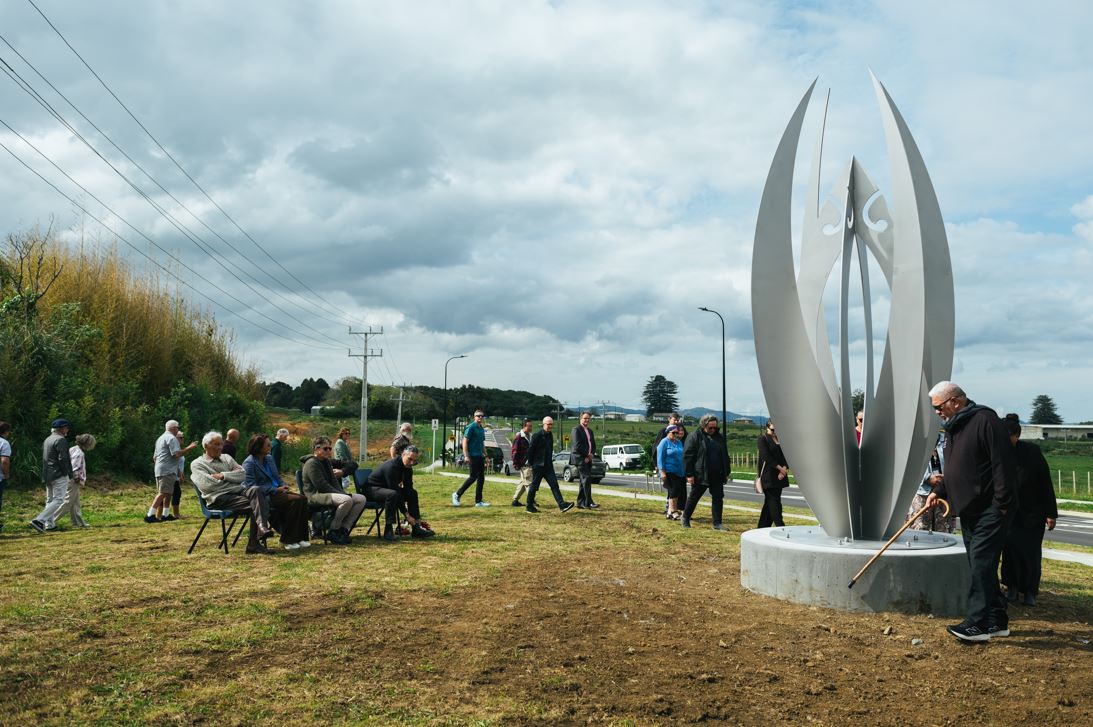Celebrated artist Fred Graham has unveiled a gift to the town he loves in the form of a sculpture carrying its name.
Waiuku becomes the latest addition to Auckland’s public art collection after its unveiling on the Glenbrook-Waiuku Road / Cornwall Road intersection.
It expresses his aroha (love) and whakawhetai (gratitude) for the town where he has lived, worked and raised his family with wife Norma for more than 30 years.
Franklin Local Board member Sharlene Druyven says Graham (Ngāti Korokī Kahukura, Tainui) is internationally and nationally celebrated and is a taonga of the area.
Now 96, he is still being commissioned – especially in Waikato – where his ancestry anchors him, with Waiuku acknowledging Ngāti Te Ata Waiohua history in the rohe (area) and the immigrants who have made it their home.
Based on the letter W, three of the four inner panels feature the koru, honouring those involved in the story of how Waiuku got its name.
Brothers Tamakae and Tamakou vied for the hand of Waikato chieftainess Te Atairehia – after whom Ngati Te Ata are named - and who is represented by a fourth koru.
Tamakae was the provider, Tamakou the orator. Tamakou was first to meet Te Atairehia but she requested Tamakae be presented. He was working in the kumara gardens and had to be washed in the wai (water) and uku (a type of white clay) at the stream that flows into the Manukau Harbour before he could meet her.
He won her heart and they married, and from then on, the area was known as Waiuku.

Graham was born in 1928 in Arapuni, going on to Taita College where his talent was recognised, a gift nurtured at Ardmore Teachers Training College.
From there he developed an interest in sculpture, teaching himself to carve in wood and stone, and later using steel – a cornerstone of Waiuku with its iron sand and mill.
He was part of a collective that ran a Te Tai Tokerau (Northland) initiative in rural Māori communities with artists such as Cliff Whiting and Paratene Matchitt known as the ‘Class of '66’ after a Hamilton show called ‘Contemporary Māori Painting and Sculpture’.
Friendships with art greats Ralph Hotere and Muru Walters were also established during his early days, while his own works fused Māori and European cultures, often combining wood, stone and modern materials in commissions displayed across Aotearoa.
“Fred is known for drawing on Māori traditions, but that is in the art world. In Waiuku he is better known for his gentleness, kindness and wisdom,” Druyven says.
“This is a man who has walked alongside greats of the art world but who is humble, who celebrates what matters to him, whanau and whenua.
“Very few of us can say we are friends with an art great, and the fact he’s just Fred to so many here in Waiuku tells you everything you need to know.”

His son Brett followed his own path, also becoming an acclaimed artist and exhibiting currently with his father and other prominent Māori artists at this year’s Venice Biennale.
Fred Graham received the Te Waka Toi Te Tohu Aroha mō Te Arikinui Dame Te Atairangikaahu Award in 2017 and a year later the Arts Foundation Icon Award and was also made an Officer of the New Zealand Order of Merit.
The 5.2 metre tall 1.4 tonne stainless steel work was made in Waiuku by retired engineer Rex Erikson, a long-term friend and collaborator.
Waiuku is the second major Graham installation in the town. In 2020 his work recognising NZ Steel’s 50th anniversary in 2015, was unveiled at Centennial Park – Lions Lake to locals.
That eight-metre steel statue features triangular panels depicting the three Franklin sites that converge to see steel forged at the mill, Taharoa, Waikato North Head and Glenbrook.
Fifty birds adorn the panels, the cut-outs recognising the lives of those connected to the mill who have passed, and the shaped birds the lives of those now associated with the mill, and the whanau supported by that relationship.
Inside the triangle, pipes can be seen, honouring the pipeline that sees iron sand shaped into steel.
Atop the structure three birds rise into the sky, the past, present and the future.
Stay connected
Sign up for your Local Board E-news and get the latest news and events direct to your inbox each month.

